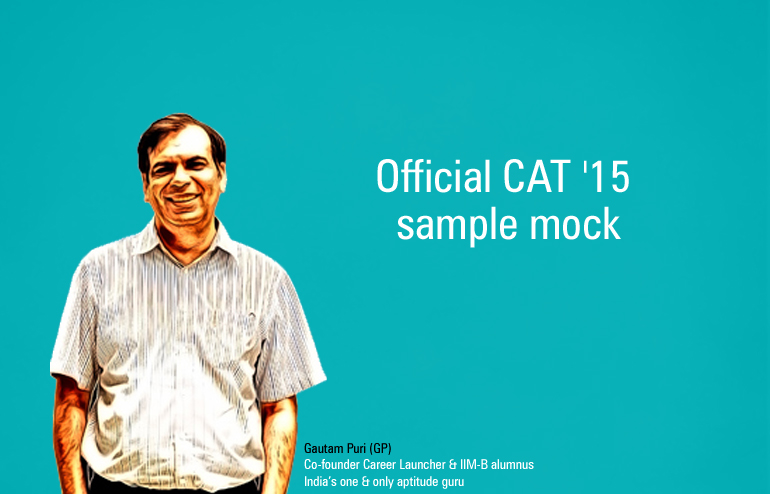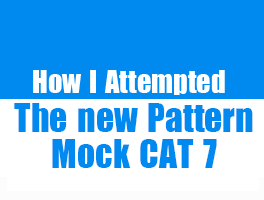Sometime back in July when IIM A announced the changes to the CAT, what was expected was a cosmetic change done to the CAT 2014 pattern – clubbing DI & LR into one separate section. Apart from that, it was also announced that there would be non-MCQ questions and also, calculator would be allowed.
What they did not announce at that time was:
• Sequence of the sections
• Number of non-MCQ questions
• Composition of VRC section – specifically, the number of RC questions
A few days ago the CAT authorities released the CAT 2015 Mock CAT* with the following details:
1. The sequence of the sections:
a. Verbal and Reading Comprehension (VRC)
b. Data Interpretation and Logical Reasoning (DILR)
c. Quantitative Aptitude (QA).
2. There are three types of questions in the paper:
a. Multiple Choice Questions with marking scheme of (+3, -1)
b. Multiple Choice Questions with marking scheme of (+3, 0)
c. Non Multiple Choice Questions with marking scheme of (+3, 0)
3. The VRC section of the sample paper consists of:
a. 24 RC questions from 5 passages with a marking scheme of (+3, -1)
b. 6 verbal logic questions with choices and a marking scheme of (+3, 0)
c. 4 Parajumbles without choices (non-MCQ) with a marking scheme of (+3, 0)
4. The DILR section consists of:
a. 24 questions in 3 data sets each of DI and LR with a marking scheme of +3, -1
b. 1 data set each of DI and LR (total 8 questions) with a marking scheme of +3, 0
5. QA section has 25 MCQs with a marking scheme of +3, -1 and 9 non MCQs with a marking scheme of +3, 0. Interestingly 7 questions have been given twice – once with choices and once in the form of non-MCQs.
6. The breakup of the question types in the paper is summarized in the table below:

7. A 20 digit scientific calculator has been provided
Unless IIM A wants to play a cruel joke with all the CAT aspirants, we would have to assume that the above would be more or less the pattern that one can expect.
CAT 2014 Mock CAT Vs CAT 2014
Last year too, CAT authorities had released a CAT 2014 Mock CAT and a comparison of the CAT 2014 Mock CAT with the actual CAT 2014 paper will help us understand what we can infer from CAT 2015 Mock CAT.
The CAT 2014 paper was similar to CAT 2014 Mock CAT in terms of the structure. Both the papers had:
1. 34 QA questions
2. 16 DI questions in 4 data sets consisting of 4 questions each
3. 16 LR questions in 4 data sets consisting of 4 questions each
4. 16 RC questions in 4 passages consisting of 4 questions each
5. 18 Verbal Logic questions
However in terms of the question types (in Verbal Logic) and the level of difficulty (in all areas) there was no correlation because all the questions in the CAT 2014 Mock CAT were randomly picked up from 2003-08 CAT papers.
While the CAT 2014 paper had very easy QA questions and RC passages, the level of difficulty of these two was medium to high in the CAT 2014 Mock CAT. In DI and LR it was the reverse with the data sets in the CAT 2014 paper being more difficult than those in CAT 2014 Mock CAT.
In terms of the question type, the gap was the widest in the Verbal section. While the Verbal questions in CAT 2014 Mock CAT had 5 FIJ questions and 7 Sentence Correction questions, the actual CAT 2014 did not have any FIJ questions and only 3 Sentence Correction questions, it also had Critical Reasoning questions that were missing in the CAT 2014 Mock CAT.
CAT 2014 Mock CAT Vs CAT 2015 Mock CAT*
While the CAT 2015 Mock CAT is being analyzed to death, most of the people have missed comparing the two Mock CATs – CAT 2014 Mock CAT and CAT 2015 Mock CAT. A comparison of the two papers shows an overlap of over 90% in these two papers.
In the VRC section of CAT 2015 Mock CAT, 4 out of the 5 RC passages, the 4 Parajumble questions and the 3 Summary questions are from CAT 2014 Mock CAT.
In the DILR section, all the 8 data sets of CAT 2015 Mock CAT were there in the CAT 2014 Mock CAT also. The only change is the removal of choices from 2 data sets.
In QA section all questions of CAT 2015 Mock CAT are from the previous year Mock CAT.
Inferences from CAT 2015 Mock CAT:
1. Paper Structure: Given that the CAT 2014 paper was identical to CAT 2014 Mock CAT in terms of the paper structure, I believe that CAT 2015 could follow the pattern of the CAT 2015 Mock CAT.
2. The VRC section in CAT 2015 Mock CAT has a bonus that many students have missed out – the 6 MCQs with a marking scheme of (+3, 0). It is difficult to say if this will be followed in the actual paper or it has come by mistake like the repetition of 7 QA questions.
3. Scientific Calculator: The purpose of this paper is possibly to make the students familiar with the platform and hence a scientific calculator is likely to be a reality. It will prove to be a great help in questions in which the last digit or the remainder is to be found out and also in questions of logs. Candidates are advised to get familiar with an on-screen scientific calculator to understand the functions of all the buttons.
4. Question types and the degree of difficulty: Given that there is over 90% overlap between the Mock CATs of 2014 and 2015 the CAT 2015 Mock CAT it cannot be taken as an indicator of either the degree of difficulty or the question types. Also since last year there was no correlation between the actual and Mock CAT 2014, it will be foolish to assume that there will be any this year. Any similarity on this account will be purely coincidental. The fact that 7 QA questions have been given twice also confirms that the focus of CAT 2015 Mock CAT is the structure and the platform and not the question type or degree of difficulty.
My Take:
The areas of concern for most of the students in the CAT 2015 Mock CAT structure are the number of non MCQs in QA and DILR and the number of RC passages (and questions) in the VRC section. To my mind these will not be a problem, let me explain why.
People by and large expect IIMA to give a difficult CAT 2015 VRC section based on the CAT 2006 paper which too was set by IIMA. However this is the only instance of a very difficult VRC by IIMA and the VRC section in other IIMA papers were of moderate level of difficulty. The statements coming out from IIMA (e.g. we are not looking for rocket scientists) indicate that the QA and DILR are unlikely to be difficulty. However there has not been any statement indicating the level of difficulty of VRC.
In the past it has been noticed that a change in pattern is usually accompanied by easier papers as the change of pattern on its own increases the level of difficulty. Thus while the number of non-MCQs at 25% in QA and DILR is high when compared to other aptitude tests that have non-MCQs but 2015 is the first year for this question type and hence these non-MCQ will most probably of low-medium level of difficulty.
My suggestion to students is not to leave questions or data sets just because they are non-MCQs, they are likely to be easy.
The most worrying aspect of the CAT 2015 Mock CAT for most students, who struggle through RCs, is the number of RC passages. To my mind 5 RC passages with 24 questions is a positive development for most students. Increase in the number of passages/questions leads to a reduction in the level of difficulty. It is usually difficult for most students to attempt more than 2 out of 4 RC passages but 5 RC passages would lead to a greater variety in the subject of the passages and attempting 15-20 questions from 3-4 out of 5 RC passages will not be difficult. Also the passages with 6 questions will definitely have at least a couple of sitters.
What you should do in the last two weeks?
DI + LR + RC = 56 questions | 168 marks!
Assuming you have done enough to clear the cut-off of Quant, the deal-breaker in the CAT, according to me, would be DI, LR, RC. If you can manage to do well these three areas, you will get high score in the CAT.
Apart from taking mocks (once in two to three days), for the next 14 days you should solve at least 5 sets on each of DI, LR, and RC every day.
Lastly, do not worry too much about the pattern of the CAT – whatever be the challenge that CAT will throw at you, handle it. In any case, every single test taker would be facing the same challenge.
(* – The Official CAT Mock CATs of 2014 and 2015, released by the CAT authorities, can be accessed in the ‘ELib’ tab in the Free SIS Account)












sir my
10th %age is -75
12th%age is – 60.03
grad. (B-tech)- 70
am i eligible for FMS if i got 98%ile -100ILE
Himanshu, yes you are eligible for FMS. Aim for a 99.5+ for a FMS call.
Gp sir,
Can you please give a rought range of score vs percentile
K santosh, please check the percentile predictor.
Hello sir,
Sir out of ~218000 applicants, how many candidates are serious and take coaching?
And does accuracy has to do anything with percentile, for eg. 150 score with 90% accuracy or 80% accuracy, which has higher percentile?
Thanks in advance.
Sandeep, my estimate is that only 25% candidates are serious.
A score of 150 in a given slot, irrespective of the accuracy, gets the same percentile.
hello Sir,
I am a CL online student.Since my slot for CAT is afternoon. Will there be a short analysis provided just after the morning slot as this will help in the afternoon slot
Anant, it will be provided.
Dear GP sir,
As you replied for most comments but for my surity i want to ask you again if i answerd wrong for non mcQ or others (approx. 27 Qo. with marking of +3,-0),will this lead me to a negative score or not ?
Tejpal, in the questions that do not have negative marking, for incorrect answers you will get a “0”.
Sir, the MCQ’s which donot carry any negative marks will be mentioned before hand in the instruction part.
Somya, yes this will be mentioned in the instructions.
Hello sir, what could be the expected cutoff percentile for a reserved category students in 2015.My brother belongs to schedule tribe is scoring around 80percentile in the mocks,what chances do he have in order to enter into any of the IIMs. what is the least percentile and minimum marks required for him to crack CAT
Prasad, 80%ile in mocks will most probably convert to a 85-90%ile in CAT and hence your brother can get calls fro all IIMs. Typically a score of 75%ile is sufficient for most IIM calls for ST candidates and a 80%ile can get all calls subject to his academic record. Please check CL’s IIM Profilizer for the list of IIMs from where you can get a call and the score required for the same.
Sir,
This is my 2nd attempt at CAT. I had scored 92.71%ile last year and had a call from IIM-S. This year, I have been taking mocks on a regular basis and according to CLPP , I have a predicted %ile of 97.84 while the best attempt stands at 99.06%ile . I feel confident in VA , especially in RCs, have been scoring around 93-99%ile. I have been scoring pretty well in LR/DI also, %ile ranging from 92-99. But the only area which concerns me is QA. scores have fluctuated between 30 and 60.But over the last few mocks it’s been ranging from 42-55. What should be my strategy so as to get good scores in QA which will obviously increase my %ile. What else can i look to improve so that I can be in the race for IIM-A and IIM-C, who have their cutoffs at 99.65 and 99.45.?
Gaurav, please refer to the post CAT 2015 – Khel Khel Mein, it will hopefully help you reach your target score in CAT.
Sir,My mocks scores have dipped in the last few unproctored mocks ,in this last few days before CAT.The previous scores were stable at 90 with cppc most likely at 95. Is it because these mocks are harder or because of the stress?How can I solve this issue?
Rishabh, call me anytime tomorrow at 9811155160 to discuss the issue.
Hello sir. I’ve a small question, what is your take on the sectional scores needed to get 95%ile plus in each section, net correct attempt with 90% accuracy?
Vikas, my estimate of net score for a 95%ile in each section is:
VRC – 48-50
DILR – 48-50
QADI – 55
Sir , I always target to give 40 mins to RC’s but end up giving only 28-30 mins as i become more cautious while attempting non-MCQ’s parajumbles ,paracompletion in the beginning which impacts my accuracy as my accuracy is good enough in RC. Same is the case with QA as i am able to attempt less ques in first 30 mins as then have to rush in last 30 mins which impacts my accuracy .Hence ,Kindly suggest how to attempt both sections to improve my scores.
Puneet, it appears that you are facing difficulty in leaving questions and hence the low attempts in the first 30 minutes and poor accuracy in the next 30 minutes. Please call me at 9811155160 in the evening after 7pm to discuss the issue.
Hello Sir,
Thanks for the post. I’ve been giving mocks regularly where my percentile lies between 85-92.
My problem is with number of attempts and a few silly mistakes that i make.
I would like your guidance on how can i improve my scores considering the problems i forementioned.
Some strategic tips you would choose to share for people who have similar issues as mine.
Also , though this may sound a question with a no certain answer , what would be your idea of marks needed to get a 95%ile + ?
Thanks again for the post:)
Vivek, call me in the evening at 9811155160 after 7pm to discuss the issues pertaining to your preparation.
Hello sir,
I am a test series student. My CLCPP 2015 shows my most likely percentile to be 96.72 percentile. I am decent in VA/RC and DILR sections (as per the performance in the mocks) but i am not very confident in QA section. Do i have a realistic chance to get a call from any of the 19 IIMs and what should my preparation strategy for the remaining days so as to maximize my chances??
Please guide me. Eagerly waiting for your reply.
Thanks.
Soumyadeep, you have a good chance of a call from the IIMs. In QA first attempt the questions that you are 100% confident of and then look at the others. Call me at 9811155160 in case you need to discuss the issue.
Sir, as the number of questions with no negative marking is at around 27, is it advisable to make wild guess for such questions if we couldn’t attempt those?
Anish, you should definitely mark an answer to questions with no negative marking.
I cant watch the Webinar coz the registration is full. So could i get a recorded version , i am a CL
student and i want to watch it but it is showing registn full. could u kindly help me ?
Aman, the webinar is available in your SIS.
Sir, how much will i have to score to get a call from SIMB banglore?
My category is OBC.
Adhiraj, Symbiosis institutes do not have reservation for OBC candidates hence you will have to target a 94%ile for SIBM Bangalore
Hello Sir,
A small correction. FIJ questions were actually present in CAT 2014 paper, at least in the morning slot of 16th Nov, 2014. There were 5 FIJ questions.
Mahesh, have checked up with the CL faculty who attempted CAT 2014 in the morning slot of 16th November, they have confirmed the absence of FIJ in the paper.
Sir,
My understanding is when the raw score of two candidates are same, who has the higher accuracy gets higher percentile. So should we attempt non mcq when we are only 100% sure or we can attempt all non mcq as there are no negative marks.
Karupriya, this is incorrect, candidates with the same raw score get the same percentile.
Hello GP sir,
My mocks based percentile predictor shows most likely percentile of 96.72 and best attempt of 99.49. I am decent in VA/RC ( consistently 90+) and DILR (80-90) but QA scores have fluctuated a lot (40-80). I am not finding any confidence in cracking the sectional cut-offs.
Do i have any realistic chance of getting into any of the 19 IIMs ?? What should be my preparation strategy for these last 5 days ??
Please guide.
P.S.- I have done my undergrad in humanities (economics).
Soumyadeep, if you can get your QA under control then you will make it to the top IIMs also. Attempt only those questions that you are sure of solving and leave the others. My estimate is that a net score of 45 marks (15 net correct answers) will ensure a good overall percentile for you. Please also go through the recording of the webinar available in your SIS for what to do in the next few days and how to tackle the QA section.
Hello sir, sir i am getting cl mock marks between 65-75 but percentile only 33-45 , why this is so ??
Nidhi, percentile is a kind of rank, a 45 percentile means that you are above 45% of the candidates.
What all colleges are there in the 90+%ile cut off(top) bracket which do not have sectional cut offs ??
KArtik, almost all institutes except IIMs, MDI, SP Jain, IIFT and XLRI give interview calls on the basis of total score and do not have sectional cutoffs.
Dear Sir,
I am a CL student and I want your guidance on VRC section as this is the section that is hampering my overall percentile.I am scoring 80-90 percentiles in DILR and Quant sections and a fluctuating percentile in VRC section.I actually get confused and afraid of the VRC section.Kindly help me in resolving the problem.As CAT is very near for now, I just want advisable tips and strategies that I can work on.
Looking forward for your reply.
Yashika, in VRC focus on practicing RC as it is expected to be about 70% of the VRC paper. Please go through the CAT 2015 webinar uploaded in your SIS for tips on how to handle the section.
Call me at 9811155160 in the evening in case you need to discuss the issue.
Dear sir,
my %ile predictor is showing 84-89ile. In last few mocks (20 and 22) I have not performed but the predictor has not shown any change. Can you please share the expected %ile in the actual mock.
Bhupinder, the percentile predictor gives a calculated percentile based on your overall performance in the season. You most likely to get a percentile in that range.
GP SIR,
Is it really possible that all the questions in the Verbal section except RC will have no negative marking ??Also,what should be the net score to get a 90 percentile in cat’15??
Aman, yes it is most likely. A 150 should fetch you a 90-95 percentile.
Sir,
I’ve given around 15 CL mocks and my percentiles have been fluctuating between 92-85. Also for a couple of mocks I ended up getting around 75 percentile. I’ve noticed that the difference between the high and the low scoring ones lies in my performance in the VRC section. I’ve always considered VRC to be the area of my strength. But my scores here have recently been fluctuating from 97 percentile to 60 percentile. I’m suffering from a case of low accuracy (especially in the RC’s). On analysis, the answers seem obvious, but while giving the mock, it is not quite so. I would really appreciate any advice that you could give, given that there is just a week left.
John, it is most probably a case of lack of concentration. Call me at 9811155160 to discuss the issue.
Hi sir
I got gmat 560. 3 years experience, IT. Is ximb executive or 2 yrs an option? I applied for great lakes but not sure if i will get a call.
Any other options?
Tha
Chandeep, XIMB Executive is yet to establish itself and should not be considered.
Hello Sir,
I scored 87th percentile in Cat’14 (due to a score skewed towards the VA section). Therefore, to get my QA concepts clear, I joined CL’s classroom program this year which helped as I got a fair grasp of the concepts taught in classroom. I completed all the fundabooks, moved to TestGym and then to full-length mocks in August. This however is not translated into the mocks as I’m scoring as low as 60th percentile in the QA and LRDI sections and a ~94-95 VA percentile, making the overall scores lie around 110. Apparently, a mixbag of questions confuses me and hence known concepts and sitters get missed and accuracy gets compromised in the haste and chaos. During the analysis part however, I’m able to crack 80% of the sections.
Sir, please help out and suggest some tips to follow for the last week and while test taking so as to increase the correct QA and LRDI attempts to ~17-20 as well. I don’t want to repeat the ’14 mistakes and am genuinely hoping for a significantly better performance this year.
Aakanksha, call me at 9811155160 today to discuss the issue.
Hi, Sir I am a CL Test Series Student, and I gave the proctored Mock CAT 22, in which the answer to Question 56 was 13.3, but I had input 13.29 and I got it wrong. Will such a thing also happen in the CAT? what would be your suggestion with regards to this situation?
– Rahul
Rahul, if an exact answer is not possible the n the question should clearly state the number of decimal places that you have to enter. If this was not mentioned in the question then you should gt marks for the question.
Thank You Sir
Sir , Will all the pwd students going to get 20 mins extra per section???..as mentioned in FAQS where its wriitten all pwd candidates with or without scribes will be given 20 min extra per eaxh section
Vivek, as per the FAQ if you have registered as a DA candidate then you will get and extra 20 min per section.
thank you Sir
Gp sir,
I would like to know, what scores in each section can lead to above 85 percentile in each section.
Santosh, my estimate is that about 12-13 net correct answers should be sufficient for a 85%ile in each section.
if someone is able to score about 85%ile in all 3 section how much aggregate percentile he/she may get??
Vivek, a 85%ile in each of the three sections would normally convert to a 90%ile in overall score.
My message was useless that’s why you have not responded me ok
Gaurav, there is no pending message under your name or email ID, please repost.
Dear Sir,
I have a technical doubt. Please help as everyone gave me a contradicting response.
Suppose we solve a question and get the answer as 3<x<5; The question states "choose the option that is always true".
Suppose the options are a)3<x<5 and b) 3<x<8. Technically both are correct right?
Basically I want to use this technique to eliminate options. Please help
Roshan, the answer should be a)3
sir
i am not able to score above 85-95 in mock cats whenever i try to stress on one part score of other section goes down how much percentile can i expect ??
Prakhar, CAT scores are usually higher than that of Mock CATs so do not let the past (Mock CAT scores) pull you down. Every paper is a new innings and you could easily score higher than what you are getting in Mock CATs. Relax and you will do well, pressurise yourself in the paper and your scores will dip.
hello sir..
m scoring 86 to 91 percentile in simcats. How much can i expect in actual CAT exam? is it advisable to fill MDI college on the basis of the score m getting in mocks?
my performance was getting hampered because of unduly n unwanted stress n overpressurisng my own self.
In the last few days i just wanted to revise all the mocks taken.. what is the best way to systematically revise them all?
Regards
mba99, it is difficult to extrapolate the score of IMS mocks since the number of students taking them is not known. If you have taken any CL Mock CAT then let me know your score. However typically a 86-91%ile in mocks should convert to a 92-95%ile in CAT. If you can relax a bit during the test then hopefully your scores will also improve.
You can apply to MDI especially if you have a good academic record.
Hello sir,
1) What are the colleges that i should apply into , given my best attempt projected percentile is 99.26 and most likely projected percentile is 93.72.
2)What should i do as i am getting 90-99 percentile in QA, LR-DI but only 75-80 in VRC.
Rishab, apply to the colleges in the 90%ile + bracket. Apart from IIMs most of the other institutes do not have any sectional cut offs and hence are possible.
Regarding the VRC issue, call me in the evening after 7pm at 9811155160
If the raw score in final is 80-90. What percentile can be expected?
Bhavna, it is likely to be 70%ile.
GP SIR, I am doing good in DILR (97-99 PERCENTILE) AND OKAYISH IN VARC WITH 92-97 PERCENTILE, But sir my QUANT IS TOO BAD….ITS AROUND 65-80 PERCENTILE ALWAYS. Sir apart from numbers and arithmetic, i cant solve anything. Sir what would be a good number of attempts in the QA section to alteast clear the 90 mark…?
Jayesh, my guess is that a score of 45 should be over 90%ile in QA, However you still have over a week to CAT and hence can definitely look at improving your QA score.
Since you are comfortable with Number System and Arithmetic you should ensure that you are able to solve all questions from this area. Additionally if possible solve all the beginner level tests in at least one more area (out of Algera and Geometry) from Test Gym Lite in your SIS, this will ensure a few more questions from the other areas as well. You can also try solving questions of Algebra by substitution.
Hello gp sir,
in my 10th-87.6%
12th-78.6%
B.E.-72.5%(mechanical)
sir i am 2014 batch pass out and currently i am not working (basically i am writing cat 2015 so officially i have 2 year gap )i am currently took cl and time mocks and scores in a range of 85-90 percentile i am very worried about it but i am working on it to improve my percentile but more important will this 2 year gap create problem for me and make my chance tough to get good b school
Shubham, the 2 year gap is an issue and you will be questioned about it in the interview. However this question can be handled, let us look at this again after you are through with CAT and other MBA entrances. Your current focus should be only on getting a good score in your MBA entrances.
hi Sir
i am constantly scoring 95 percentile in mocks,I am aiming only for IIMs. What can be done in the next 10 days to improve my score
Anupama, a 95%ile in Mocks typically converts to around 98%ile in CAT and hence you are on the right track. As suggested in the last part of of this post, in these last few days while you should continue practicing and revising questions from all areas, DI, LR and RC should get some extra attention.
Hello Sir,
I have a few small questions.
1. What is your take on a 99%ile, for this year in terms of the marks?
2. According to you, how high is the possibility of the (3,0) mcqs appearing in the real paper?
3. I have been doing decent in my mocks, in all areas.i.e getting 90%ile plus in the mocks. Considering that what will be your advice for the final 10 days befo0re the d day?
Vivek, this is difficult but my feeling is that 170-175 should be sufficient for a 99%ile in CAT 2015.
(+3,0) MCQs do not make sense but since the Mock CAT on the CAT website shows this question type I will not rule them out.
A 90%ile in CL Mocks typically translates to a 95%ile in CAT and a small tweaking of the way you take the paper or some extra practice and revision can take you to the next level. As suggested in the last part of of this post, in these last few days while you should continue practicing and revising questions from all areas, DI, LR and RC should get some extra attention.
Sir, I have been giving cl mock cats since may 2015 and I am still not able to score above 100 overall but I am able to score well in iift mocks and xat old papers, so what should I do in order to score well in cat 2015?
Thanks in advance.
Rishab, each exam is very different and probably IIFT and XAT pattern suits your style of test taking more. Since you haven’t bee able to cross 100 since May, you need not worry a lot about the CAT mocks scores and should just look at revising everything a maximizing your attempts on the day.
Hello GP sir,
As seen that the number of NON MCQ questions if high and in mock cat 22 we have seen that 5-6 non mcq para jumbles were there. As VRC is my weakest section, due to the non availability of options I am getting most of these wrong. My accuracy otherwise was decent. I have scored only 35 marks in VRC section in mock cat 22. So are there any tricks to solve these type of parajumbles??
Thank you
Kushagra, Non-MCQ questions usually don’t have any tricks and it naturally is difficult since the options aren’t there. You should analyze Mock-22 to understand the thought process of the author. It might help you get a perspective.
Hello Sir,
I have taken several CL mocks but not able to perform well. I’m always finding myself on back foot when it comes to Verbal section and even in DI also. I’m not able to cross 80%ile in mocks. So tell me what should I do to take my percentile to 92-95%ile bracket. And also kindly let me know that what score will lead me to 92-95%ile bracket.Thanks in advance.
Vishnu, practice DI-LR-RC sets daily. These constitute the major part of the paper this year. Analysis of each and every mock is a must. Assuming the same level of difficulty as CAT 2014, the estimate for the score required for a 99%ile in CAT 2014 is:
QA – net score of 70-75
DILR – net score of 65-70
VRC – net score of 55-60
Overall – net score of around 175
Dear Sir
Non MCQ questions and the questions with +3,0 marking scheme will not fetch any negative.
Will it affect the percentile during normalization if one guesses them incorrectly which will increase the number of wrongly answered questions?
thanks and regards
Ajay Gupta
Ajay, accuracy is not considered during normalization or percentile calculation hence it will not be a problem.
Thank you sir 🙂
Hi GP Sir,
Hope you’re doing well.
Thanks for your thorough review and feedback, as always. How do you suggest to practice RC, DI and LR sets? Would the Test Gym be suffice? I somehow find it appropriate along with Part-V of the Book Packets that I received. If yes, what levels should we focus for our practice the most, Basic, Advanced or Expert?
I’m also trying to find a balance between CAT and IIFT (mocks, previous year papers, etc.) attempts during this time.
Many Thanks for your response,
Shivam Kapoor
Shivam, for Quant you need not go beyond the Advanced level. For VA and RC you can try out the Expert level. You must attempt atleast 4-5 IIFT mocks before you sit for the paper. IIFT is about speed, you need to get into that grove.
CAT has changed the calculator format and have also added new buttons. You have any clue?
Gulshan, will come out with my inputs on the calculator shortly.
Sir, I’m not able to attempt even medium level geometry questions. I’m getting 85-95 in QA 85-95 in DI/LR and 95-99 in VA .Overall between 92-99. Should I just avoid geometry from now
Hari, go through the geometry questions in the old CAT papers and if you are able to solve them then you can try the geometry questions in the paper else leave them.
What is the issue in QA and DILR, 85-95 in both means that a small tweaking in the way you attempt the sections or some revision could take you to the next level in these two sections and in overall.
Hi GP sir, Can CL team upload a document which can guide us in using various functions of scientific calculator and help save a lot of time? eg. as you mentioned the questions asking remainders and logs. Although, I assume that it is unlikely to have direct calculator based question but still let us know this, if you think there is a chance that a straight forward calculator based question could come which could otherwise take sometime to solve via regular approach.
Kapil, this will be done shortly.
Sir, I am a student of CL’s classroom program.
I’ve completed all the funds books.
My scores are in range of 90-110 but my sectional performance in VRC Section is inconsistent with 60-70% accuracy.
Please advice some last moment mantra.
Haimanshu, Refer to the last paragraph of this post and practice RC daily along with analysis of the tests. Also do practice past CAT papers as suggested in the post 5 Weeks to CAT’15 – Ab billi door nahin.
Call me in the evening at 9811155160 in case you need to discuss the issue.
Expected marks vs percentile for cat 2015
Karan, assuming the same level of difficulty as CAT 2014, the estimate for the score required for a 99%ile in CAT 2015 is:
QA – net score of 70-75
DILR – net score of 65-70
VRC – net score of 55-60
Overall – net score of around 175
sir i am in pre final year and will be appearing in cat 2016. i have 90% in 10th and 65% in 12th . in graduation i have 70% upto now. i am btech in dairy technology. will iims will be possible for me with poor acadmics though i may get some weightage for diversity factor in some iims? how is the abm programs at IIMA and IIML? what are there cut off for general catogory?
Abhilash, your XII is low but X and graduation are fine and hence most IIMs are possible. Also given that you are a Dairy Technology you can get calls from the ABM program IIM A and L at low percentiles also. These programs are as good as the regular MBA program and provide excellent placement opportunities.
Hi GP sir,
I am a student of Career Launcher at Bangalore.My CL proc mock percentiles vary from 75-90.(Highest score till now is 119 )
Section split percentile:
Verbal-75-85
LRDI-75-85
Quant-80-90
Sir, please suggest me what to do in these last two weeks to put my score above 150 in the final clearing sectional cutoffs.Any help would be highly appreciated.Thanks in advance!
Sai, to go up you will have to improve your scores in the weak areas – LRDI and VRC. Fortunately both these can be improved by regular practice and practising 4-5 data sets/passages each of DI, LR and RC will be important. Also the ones that you find difficult or time consuming should be revised once in 4 days. Please refer to the last part of this article “What should you do in the last two weeks?”
DO attempt the old CAT papers as suggested in the article 5 Weeks to CAT’15 – Ab billi door nahin.
Good Evening GP sir
I joined the CL mocks quite late and have written only a few till now. This is how they have been. Mock 09- 101, Mock 11- 113, Mock 12- 139, Mock 13- 149, Mock 19- 136, Mock 20- 149, Mock 22- 132. I have also been writing IMS Mocks with scores ranging from 120-179, but somehow they were peaking around Oct but have come down to 130’s now. Any word of advice for these last few days?
CAT 14 score was 123.28. I know that being an easy paper, it was low, but even this year with all the effort scores haven’t been in the range of 150+ . Right now I’m going through the past mocks, few CAT papers and obviously the few left mocks. Anything else apart from this?
Vijay, I will not be able to comment on the IMS mocks (since I have not seen them) but as far as the CL Mocks are concerned by and large your score are fine because almost all these papers are more difficult than CAT 2104. Regarding the reduction in your raw score, just check your your percentile, as long as it is 97+ I would not worry too much about the raw score.
In the last few days your can follow what I have mentioned in the last part of this post and/or what I have suggested in the post 5 Weeks to CAT’15 – Ab billi door nahin
HI Sir,
Your blog is excellent and has been very helpful ..
Where can we view how the paper has been attempted by the experts?
Urvashi, this paper has not been attempted any any of us as yet. Recording of the other papers are available in your SIS.
Sir what should be the order of attempts in QA and DILR?? Should we attempt to solve the Non-MCQs first and then move on to the MCQS?
Smriti, I would not really differentiate between the MCQs and non MCQs in these two sections, I will read the question (or data set) if I find it easy will solve it there and then else mark it for R2.
So, does it change the safe number of attempts per section? or what should, now, be the number of attempts in each section to have a safe percentile?
Kapil, I think that a safe attempt will be in the region of 70-75.Target about 25 questions in each section.
GP, you mean 70-75 overall attempts or are you talking about a 100% accuracy case(after that, every 3 questions should be accompanied by at least 1 correct attempt kind of thing)? Also, last year you said around 55 attempts(As far as I can remember, I can be wrong though.) So, you are expecting we will get a paper of similar difficulty? Because we had to attempt much more than we targeted.
Although, I am fully aware that we should not aim for fictitious cut offs and imaginary safe attempts, and rather give due respect to the paper.
Thanks in advance.
Ravinder, last year I expected an easy paper and hence felt that 2/3rd attempts (around 65 questions) would be sufficient. However it turned out to be easiest paper in the last 20 years and a good attempt was around 80 with 99%ile at a net score of 185-190. This year I expect a slightly more difficult paper as compared to last year and also the presence of non MCQs would lead to reduced attempts (especially in VRC) and hence 70-75 should be a good attempt this year.
Hi Sir,
Will it be mentioned whether which MCQ question in VRC would be carrying (+3,0) marking scheme ?
Hrishabh, in the official CAT Mock it was mentioned. However, all the non-NCQ questions will have a (+3,0) marking scheme.
Hrishabh, the marking scheme will most probably be mentioned.
GP sir thank you for the excellent guidance you give us all the time. However, i would like to confess that I have been scoring consistently low in my mocks. There are mocks in which I am scoring more than 100 and in the immediate next mock, the score falls down to even 60 levels. I have scored 84%ile in CAT 2013. Please give me some last moment Mantra sir. I have done B Tech from NIT-Jamshedpur with 4+year work ex.
Rohit, call me at 9811155160 after 4pm today to discuss the issue.
What score we should be looking to target to get above 99 percentile? I know it is difficult to predict the level of exam right now but can you atleast provide a range? Also if possible individual section scores to get above 98%?
Qaz, my estimate is that 99%ile is likely to be at a score of 170-175 while 98%ile in a section could be in the range of 50-55 marks.
Dear GP sir… Sorry I did not check your comment as I was travelling since last two days. I shall surely give you a call tomorrow. Thank you for being so extremely helpful. Additionally, I would like to tell you that I have given all my mocks(both proc and unproc, 22 in total) very seriously and analyzed them afterwards with utter dedication. However, I am not finding any difference in my latest scores. I would point our that, I am able to do almost 80% of the Quant questions during the analyzing part. I need a lot of work in DILR. On my best days, I am scoring over 90%ile in VRC. My scores are confusing me to limits.
Please help sir. I really want to get into old IIMs.
Rohit, let us discuss this over a call as I will need ore information. Any day after 7pm is fine with me.
Sir, does this mean that vocab and sentence correction might not come at all? If I have to choose between the 2.. intensive reading and grammar concepts, should I focus on reading?
Sachin, vocab and sentence correction questions can come in the paper and while I will not ignore these completely my focus in the next two weeks would be on RC because it is helpful in critical reasoning and summary questions also.
Hi Sir,
I joined CL mocks quite late and have written only a few ones till namely Mock 09-101, Mock 12- 139, Mock 19- 136, Mock 20- 149, Mock 22- 132. Point is, I am more comfortable when the VA section is exactly the same as is in the Mock by the IIMs i.e. RC’s, Odd Sentence, CR, PJ, PC, Summaries and dread the Vocab and Phrasal Verbs. So by the looks of it, will I be right in sticking to my strong areas now with just a couple of weeks left? I even write the Simcats. Scores have ranged from 120-180 averaging around 140.
Also my QA is a bit shaky. The last few mocks have given me 49, 65, 46, 54, 40(CL mocks) I struggle with accuracy a bit in the final 20 mins or so. What should be the best strategy for these left days? For now I’m just writing mocks once in 2 days( with analysis), Past mocks revision and CAT papers( Selectively).
Vijay, I will not be able to comment on the IMS Simcats since I have not seen the papers but your Mock CAT performance shows that you are track for a score of around 98.5%ile and hence there is no reason for you to change your approach. In any case it is too late to try and improve in your week areas, it is your strong areas that will take you through.
Regarding QA please call me at 9811155160 in the evening (after 7pm) to discuss the issue and work out a solution.
Sir,
should we expect some questions from vocab and error base ???
Sachchidanand, they weren’t there in the Official Mock CAT and also in CAT 2014. It is a bit unlikely.
Sir, I am a student of CL’s Test series. My percentiles in mocks have been uptil now varied around 85-96. The LRDI section seems to be problem area for me. I am very inconsistent and my percentile is stuck around 85% in this section. I have completed all the fundabooks of LRDI and now I am clueless as what to do. My QA percentile vary from 85-95 with VA above 95. What should I do in these last few weeks. Any help would be appreciated.
Abhinav, it is very important to practice 2-3 DI and LR sets every day. Take a few more mocks in these days.
Sir, I am a student of CL’s Test series. My percentiles in mocks have varied from 88-98, averaging around 95-96. The problem area for me is mainly LRDI section. My percentile seems to be stuck around 85%ile sometimes quite less. I have completed all the fundabooks for LRDI, I am clueless as to what should I do at this stage. Also my percentile in QA section varies around 85-95% but VA is generally 95+. Any help would be appreciated.
Abhinav, call me after 4pm to day at 9811155160 or any other day after 630pm.
Sir,
I have done B.Sc. Hons in Botany. I wish to pursue ABM in near future. I have applied in SIIB and IIM-A. Could you please suggest me few more colleges for pursuing ABM?
Alisha, apart from IIMA, hopefully you have applied to IIML ABM also. Apart from these two you can also consider Rural Management program of IRMA. SIIB ABM is low in terms of opportunities and should at best be looked at as a back up option.
Hello Sir,
Regarding the number of RC passages and also the number of questions per set,
what should be the average time in the paper given to these passages? because RC’s will decide the faith of CAT 2015…!!!
Amit, in case CAT 2015 is similar to the CAT 2015 Mock CAT my suggestion is to look at 40 minutes for RC and 20 minutes for Verbal Logic.
Thanks a lot sir,
your videos on how you attempt cl mocks is really helpful and I guess you would come up with a video(it will help sir) on how to attempt verbal logic questions with high accuracy (before cat 2015). gejo sir’s attempt is also very useful for the preparation.
Regards
Amit, will try and come out with one.
Sir,
So should we actually expect 5-6 passages with 24 questions?
Ayush, this is what data suggests.